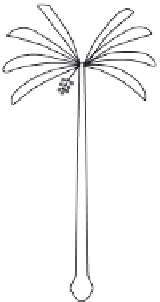Biology Reference
In-Depth Information
(A)
(B)
(C)
Figure 1.25
Three plant architectural models. Corner's model (A) concerns unbranched
plants with lateral inflorescences. Leeuwenberg's model (B) consists of a sympodial succession
of equivalent sympodial units, each of which is orthotropic and determinate in its growth.
Rauh's model (C) is represented by numerous woody plants where growth and branching are
rhythmic, all axes are monopodial and sexuality is lateral (
Barthélémy and Caraglio, 2007
).
metazoans to higher vertebrates. There are no known specialized hormone-releasing
organs and cells in plants that are comparable to the endocrine glands in animals;
even in lower metazoans, such as cnidarians, the secretory cells of the neural net are
specialized in the production of hormonal substances (peptides). The level of hor-
monal control of development in plants corresponds to the level of hormonal control
accomplished by hormones released by the target endocrine glands (thymus, thyroid,
parathyroid, ovaries and testes, adrenal, and pancreatic gland) and nonendocrine
organs (intestines, kidneys, etc.).
In metazoans, the controls at the supracellular organismic level form a strict hier-
archy that in a simplified form looks as follows:
The
nonendocrine brain
axis (
endocrine brain
in invertebrates such as insects)
The
hypothalamus
The
pituitary
The
target endocrine glands
There is no visible reason to believe that plants must have a hierarchic control
system similar to the one seen in animals. However, what we are clearly missing in
the plant control system is the controller, a center that is indispensable for continu-
ally monitoring the
system
, maintaining homeostasis and controlling the reproduc-
tion of plants and lifelong reproduction of their organs.
Recent experimental evidence has accumulated, and theoretical models have been
developed on possible separate or even integrated control systems and controllers.













Search WWH ::

Custom Search